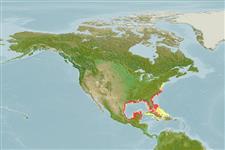>
Siluriformes (Catfishes) >
Ariidae (Sea catfishes) > Ariinae
Etymology: Ariopsis: Greek, ari = very, strength, superiority + Greek, opsis = appearance (Ref. 45335).
More on author: Linnaeus.
Environment: milieu / Klimaatzone / Diepte / distribution range
Ecologie
marien; brak water rifbewoner. Subtropical; 43°N - 18°N, 98°W - 68°W
Western Atlantic: Massachusetts and northern Gulf of Mexico to southern Florida in USA and Mexico.
Lengte bij maturiteit / Grootte / Gewicht / Leeftijd
Maturiteit: Lm ?, range 13 - ? cm
Max length : 70.0 cm TL mannelijk / geslacht onbekend; (Ref. 40637); common length : 25.0 cm TL mannelijk / geslacht onbekend; (Ref. 3265); max. gepubliceerd gewicht: 5.5 kg (Ref. 7251)
This species is distinguished from its congeners by the following characters: gill rakers on the first and second gill arches 29-32; osseous medial groove present; fleshy medial groove of neurocranium conspicuous and long, always surpassing the posterior margin of eyes; lateral margin of sphenotic notched, narrower medially than anteriorly; pterotic lateral margin smoothly convex; lateral margin of sphenotic notched, narrower medially than anteriorly; mouth 9.1-11.5% SL; close anterior nostrils 4.6-6.4% SL, close posterior nostrils 4.2-7.1% SL; mesethmoid median portion narrow, mesethmoid medial notch narrow and deep; gill rakers on the first gill arch 13–15, rarely 16; external posterior branch of lateral ethmoid columnar and thin; fenestra delimited by mesethmoid and lateral ethmoid conspicuous (Ref. 116660).
Cross section: oval.
Adults inhabit continental waters and enter estuaries. Found in turbid waters over muddy bottoms. Males incubate eggs in the mouth (Ref. 205). Commonly captured from catwalks, bridges and piers, particularly in passes and inland waterways. Edible, but generally not consumed (Ref. 7251).
Males carry the eggs in the mouth (Ref. 205).
Marceniuk, A.P., A.P. Acero, R. Cooke and R. Betancur-R, 2017. Taxonomic revision of the new world genus Ariopsis Gill (Siluriformes: Ariidae), with description of two new species. Zootaxa 4290(1):1-42. (Ref. 116660)
Status op de Rode Lijst van het IUCN (Ref. 130435: Version 2025-1)
Gevaar voor de mens
Traumatogenic (Ref. 58010)
Gebruik door de mens
Visserij: van minder commercieel belang; sportvis: ja
Tools
Speciale rapporten
Download XML
Internetbronnen
Estimates based on models
Preferred temperature (Ref.
123201): 23.3 - 27.8, mean 26.4 °C (based on 368 cells).
Fylogenetische diversiteitsindex (Ref.
82804): PD
50 = 0.5039 [Uniqueness, from 0.5 = low to 2.0 = high].
Bayesian length-weight: a=0.00631 (0.00513 - 0.00775), b=3.16 (3.10 - 3.22), in cm total length, based on LWR estimates for this species (Ref.
93245).
Trofisch niveau (Ref.
69278): 3.2 ±0.0 se; based on diet studies.
Weerstandsvermogen (Ref.
120179): laag, minimale populatieverdubbelingstijd 4,5-14 jaar (Fec=55).
Fishing Vulnerability (Ref.
59153): Moderate to high vulnerability (48 of 100).
🛈
Nutrients (Ref.
124155): Calcium = 23.7 [8.3, 68.5] mg/100g; Iron = 0.501 [0.257, 0.899] mg/100g; Protein = 18.3 [16.5, 20.3] %; Omega3 = 0.13 [0.06, 0.26] g/100g; Selenium = 16.3 [7.1, 38.2] μg/100g; VitaminA = 37.1 [11.4, 129.3] μg/100g; Zinc = 0.927 [0.557, 1.534] mg/100g (wet weight);
